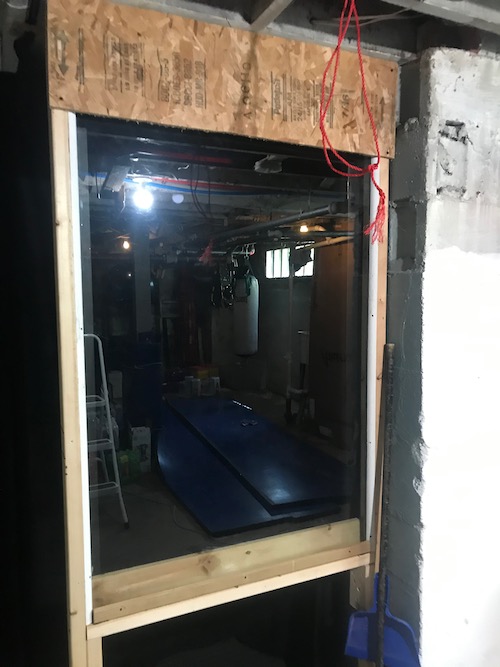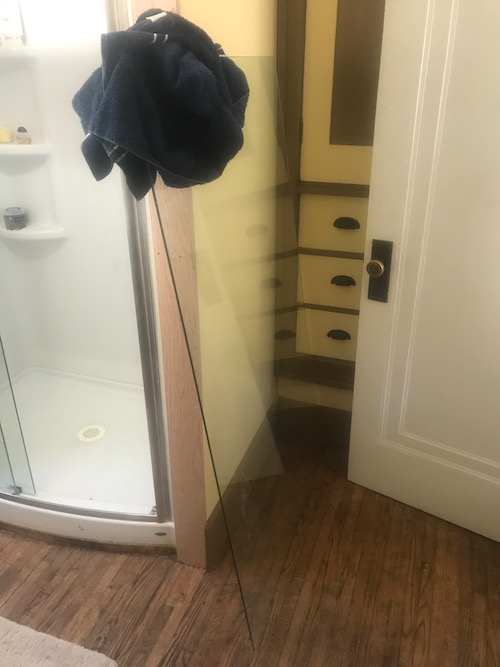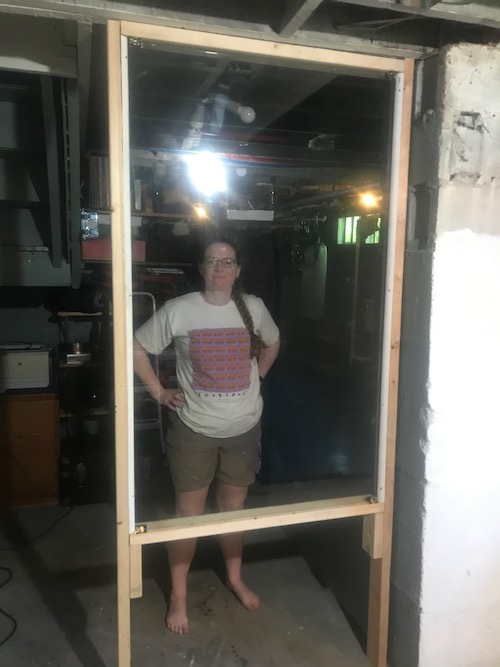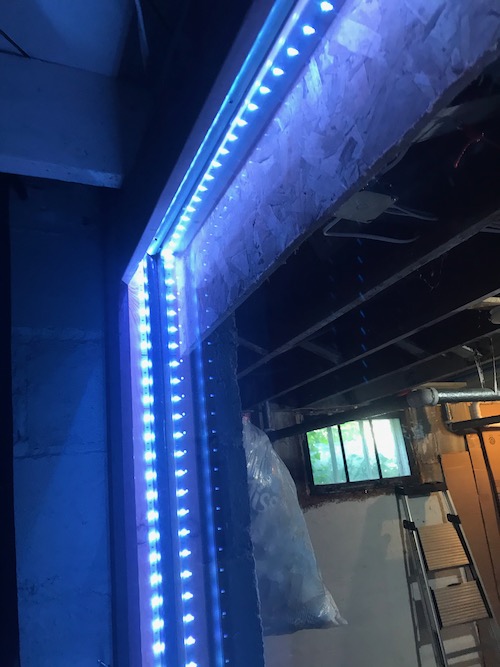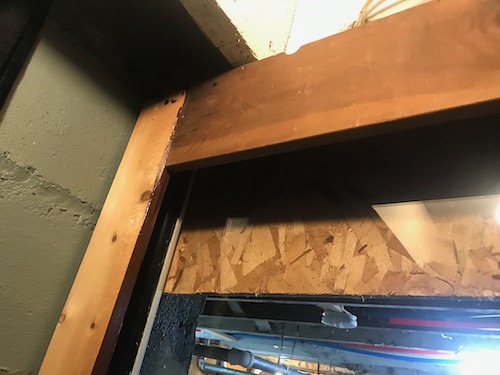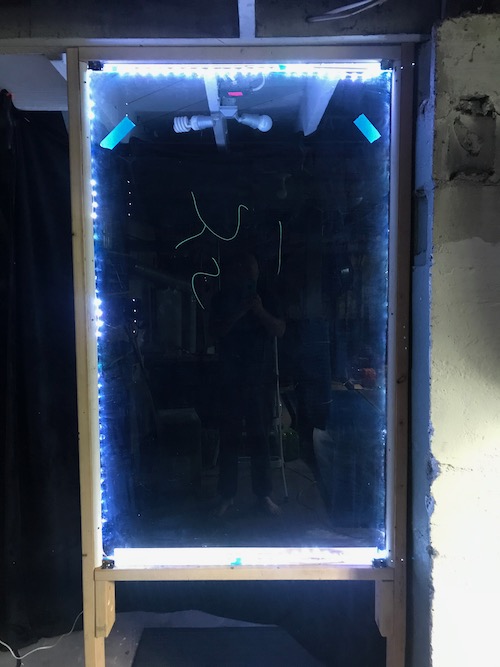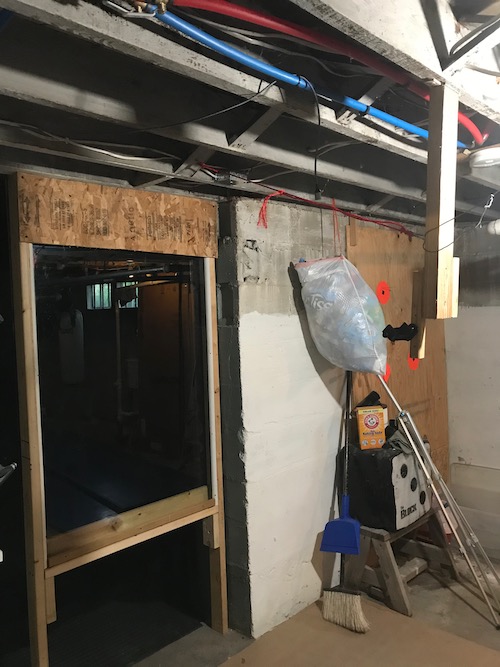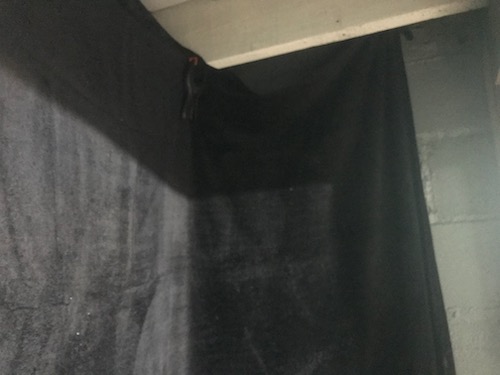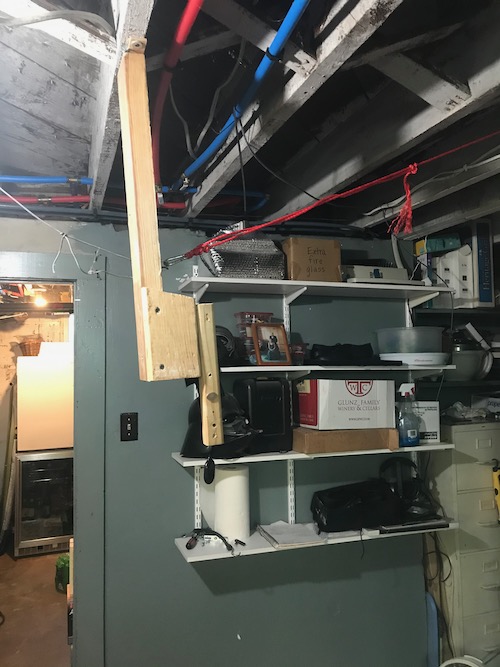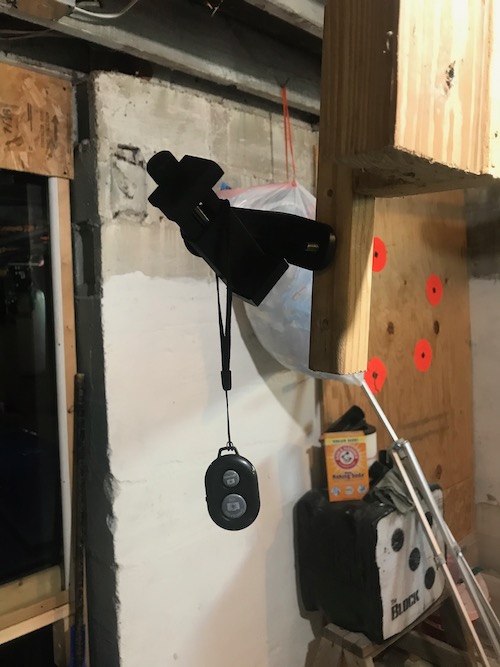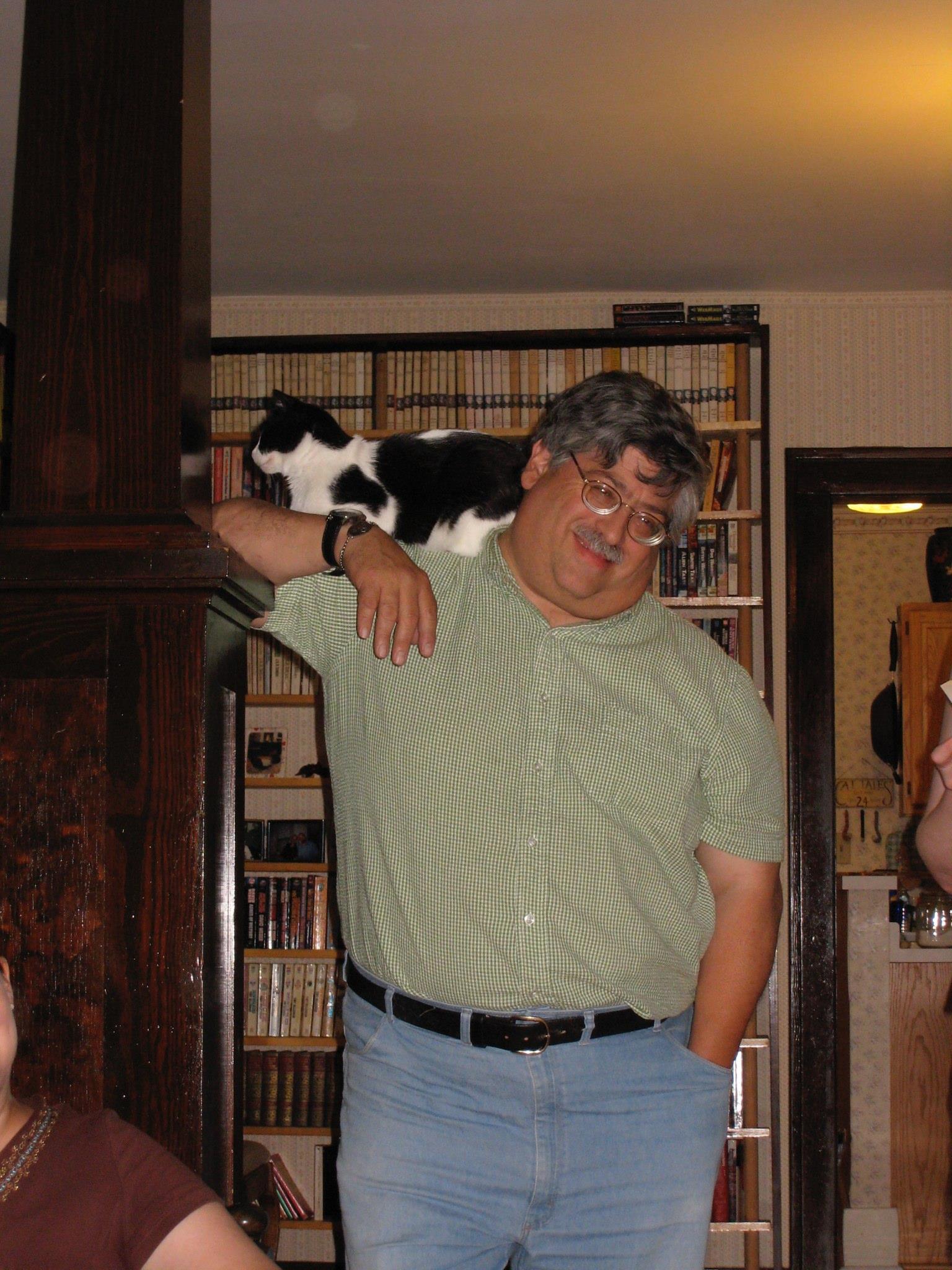Category: Politics/Public Service
Building a Light Board from Odds and Ends
I built my wife a lightboard for online teaching purposes for the fall semester because covid-19 means she’ll be teaching from home. If you’re coming here from Facebook or Twitter, you’ve already seen how this thing works with Laura’s demo video.
If you’re coming in some other way, your first question is probably what’s a lightboard? It’s a way for a teacher to both face their students and be able to draw on a board so that students can see what the teacher is doing. It works like this:
Either way, a couple of people have asked me to write up the process. So, here goes. First, this isn’t a particularly difficult project and it doesn’t require a lot of tools.
Tools:
Tape measure.
Saw that will cut boards at 90º (I used a power miter saw).
Drill or screwgun.
1 small stepladder
Ear protection (if you’re using a loud saw)
Eye protection (likewise for the saw)
Materials:
I mostly used scrap I had around the house, but I’ll lay this out as though you were buying fresh.
3 Eight foot 2″ x 4″s
3 Eight foot 1″ x “4s
5 Eight foot pieces of quarter-round or similar trim (or ~36 feet total)
1 Four foot 1″ x 12″
1 Large sheet of glass. (I used 3′ x ‘5 plate, but poly or window glass would work)
20 3-1/2″ screws (I used deck screws, but any power driveable screw will do)
50 1-1/4 inch screws (I used a mix of sheetrock and finish screws)
Optional 8 small steel L-brackets.
1 King size black fleece bedspread
1 pint (or spray can) matte black paint
1 Sixteen foot color variable adhesive LED strip light with remote
1 Cell phone tripod mount and remote
1 Cell phone with video capability
1 Blue tooth earpiece
1 Tripod or other camera base (I used a 2″ x 4” hinge-mounted to the ceiling)
4 clamps (holding the backdrop, and screws or binder clips would work too)
1 Set of Neon/Window glass markers (we used EXPO 1752226 Neon Dry Erase Markers)
Construction:
I’ll start with a shot of the end product minus the fancy lighting. Not much to look at, right? What you’re seeing here is a camera side view of the lightboard. As you can see, the basic frame to hold the glass is made of two-by-fours with quarter round holding it in place. the piece of chipboard across the top is there to mask the overhead light that lights Laura while she’s using the lightboard. The red line is part of the system for locking the camera mount in place when it’s not folded up against the ceiling. The board you see bottom back is on the far side of the glass and masks the LED strip so that it doesn’t overlight Laura.
Step One: Find a place in the house where you can put the lightboard up as a permanent fixture and not have it be an impediment to anything else. It needs three to four feet behind the glass to fit the teacher and the light-absorbing black backdrop, and another four to five feet in front to give the camera enough space. It also has to be a room that can be made very dark. In our case that meant the basement under our back stairs.
Step Two: Measure the distance between the floor and the ceiling so you can cut the vertical two-by-fours to the right length. In our case, that meant slightly longer than the height between the floor and the overhead joists so that I could screw through the joists to attach the top ends. I used pressure to hold the base in place, because it’s concrete and so is the wall. If I were mounting this in an upstairs room, I’d have hard mounted one of the verticals to a wall stud.
Step Three: Cut the two-by-fours to length. Vertical length was determined by the height of the ceiling as noted above. Horizontal length came from the size of the glass sheet. In our case that was three by five feet, so the horizontal cut was three feet. Materials shots below.
Two-by-fours salvaged from an old platform someone threw out.
Glass sheet (from a long ago project)
Salvaged 2″x 4″ + quarter-round trim salvaged from bathoom gut-out.
Step Four: Assemble the basic two-by-four framework. I did this on our back deck where I could lay things out flat and create an opening of the right size to fit the glass with right angle corners as perfect as I could make them. The glass has basically zero tolerance for any variability in the frame, so I gave myself an extra 1/16th of an inch vertically and horizontally beyond the basic size of the glass to give me a little slop to account for the frame boards not being perfectly straight. I used three heavy screws at each corner to make it tough. I also left the bottom corner on the side away from the wall only partly screwed in because I thought the glass might not slot in perfectly (it didn’t and I had to open it when we put the glass in place and then close it again once we had it set).
Frame in place but without any mounting hardware.
Step Five: Mounting hardware. I chose to put four small L-brackets in place at the corners in order to backstop the glass as I was putting it in. This isn’t necessary, because you can achieve the same effect by simply screwing the quarter-round in place on the camera side of the glass. In either case, the camera side mounts should be placed so that the glass will sit about 3/4 of an inch from the camera side edge of the two-by-four frame because you need space on the back for the lighting system. I used one inch quarter round lengths trimmed to fit with a simple square join because I had salvage wood and didn’t want to do fancier joins, but you could easily use shorter pieces if you’ve got them. The quarter round serves a dual purpose in that it both holds the glass in place and masks the lights so they don’t dazzle the camera.
Frame with L-brackets top and bottom.
Step Six: Putting the glass in. This is ideally a two person job, especially if you’re using a large piece of plate glass, like I did. In a perfect world you pick up the glass, set the bottom on top of the bottom board, slide it tight against the brackets or quarter round, and then tip the top in and get your second person to hold it in place while you mount the back quarter round. The most important thing to remember here is to not hit the glass with the screws for the quarter-round. Also, this is why I used screws rather than finish nails. I also installed a couple of two-by-four supports on the inside of the verticals under the frame proper because I always over engineer.
Glass in place between quarter-round layers, plus bits for later.
Glass up, and extra supports in place, but nothing else done yet.
Step Seven: Lights. We used these LED Strip Lights with Remote from Amazon for $17.99. It’s a 16.4 foot strip with adhesive backing. I very carefully attached the plug-in end at the top and unrolled it around the inner surface of the glass frame on the backdrop side immediately adjacent to the quarter-round. I also put an extra screwed down anchor at the plug in end to support the weight of the plug and cord to keep it from coming unstuck. When I did that I was very careful to NOT drill through the LED strip.
The LEDs are the strip of white to the left of the black quarter-round.
This is how it looks lit.
Step Eight: Back masking. It turns out the LEDs put out a lot of light that hits the backdrop area and makes it harder to see the lightboard drawings, so I needed to put up extra masking to help keep the light from the LEDs in the plane of the glass. I used one-by-four boards attached to the outside of the two-by-four glass frame as seen below. I cut six footers down to the exact size of the frame, but you could easily use shorter scrap boards.
One-by-four masking boards left over from some previous project.
Lights on, backdrop up, but only partially masked.
Step Nine: Front masking. With the masking that keeps the LEDs in the plane of the glass, they don’t put out quite enough light to show the user properly, so we are using an overhead fixture that was already in place at the beginning of the process for that. However, in order to keep it from dazzling the camera we needed a little extra front masking. I used a piece of chipboard scrap as seen in the picture immediately below. It’s 3′ 3″ long by 11″ wide, and would be replaced by the one-by-twelve listed in the materials list if you were buying new. It’s screwed directly to the camera side of the two-by-four frame.
Front masking.
Step Ten: Backdrop. We used a king-sized fleece bed cover, because the combination of texture and size was perfect for absorbing light and because it was cheap (27.99) at Amazon. Flannel Fleece Plush King. To mount it I just grabbed a couple of pressure clamps from my workroom and clipped them to the joists, but I will use screws with large washers or binder clips screwed into the joists to replace them. If I were doing this in a room with a ceiling, I’d start by putting up the binder clips and then clipping them in place. As you can see from the picture, I’ve got the backdrop mounted so that it creates a box around the user with fleece on three side and the lightboard on the fourth.
Fleece blanket backdrop from Amazon
Step Ten A: Camera mount part one. This is a serious kludge. I hinge mounted a piece of two-by-four to an overhead joist because we needed to be able to fold the mount out of the way when not in use. And then I had to add a couple of pieces of board to get the camera to sit at the right focal point since that was between joists. If it didn’t need to move it would have been much simpler. I would have put a board across between the joists, screwed a vertical piece cut to the exact length I needed and been done with it.
Step Ten B: Camera mount part 2. I drilled a hole through the piece of two-by-two and mounted a machine screw that is the size of a standard camera tripod base. With that in place it’s simple enough to screw a cell phone camera mount onto the base. You could also simply use a tripod if you had one around. The cell phone base was another cheap amazon purchase at $13.95. We used this one because it came with a remote.
That’s pretty much it. Laura records the video with her cell phone using a blu tooth earpiece as a microphone, and then flips it before posting.
One final note: This is not a difficult project, though it took a lot of fine tuning one the lighting and masking. I am a handy sort of individual with a good bit of construction experience since, but anyone with a saw, a screwgun, the materials, and a bit of can probably manage it.
On Kindness
Community Means Helping People
I had an experience today that reminds me of why I support the social safety net and why I wish we were doing better at creating and maintaining those systems.
I biked to a doctor’s appointment this morning. When I pulled my bike in under the shade of a tree to lock it up, I noticed a young woman sitting there, somewhere in the 19-25 year old range. She was looking more than a little ragged around the edges, and tired, and she was on her phone.
I nodded at her, but I was very careful not to pay too much attention to her. As a burly white guy I know that it is incredibly easy and not unreasonable for women to see me as a potentially serious danger. I figure I pretty much register as the threat equivalent of a puma entering your space. As I was locking my bike up I couldn’t help overhearing her making an effort to access local social services in hopes of finding a safe place to sleep.
Once I was completely locked up and ready to go in, I pulled out a $20 and offered it to her, saying I’d been in rough places too, and I hoped she found what she needed. Then, as soon as she took it, I immediately went in to my appointment. Again, I wanted to be as minimally threatening as possible.
When I got done with my appointment I came back out to my bike. The woman was still there, but no longer on her phone. She didn’t make eye contact, and I made sure to do no more than nod in her direction and then ignore her as I got my bike loose and put my gear back on. Just as I was about to start pedaling and after it was obvious I wasn’t going to bother her more she called out, “I wish you safe travels.” So I wished her luck and went on my way. I don’t know if she found what she needed, but I hope she did.
I would have liked to have done more for her, but it was clear from her body language that she was very wary of me, and I feel it’s important to respect that because I’m quite aware that while personally I am not a threat to her, for her demographic she has every reason to be super cautious around folks like me. So, all that I can hope is that through my taxes and my efforts at supporting good social services as a local elected official that the resources are there for her to access.
As far as I’m concerned, being there for people like her who are in obvious need is one of the important reasons for government to exist, and it’s why I would cheerfully pay more in taxes to make those resources available. I’m glad I was able to help a little, and I would happily have helped more, but I think that it would be better for community and general well being if there were stronger systems in place to make sure that help is available on an institutional rather than a personal level. It’s a hugely important investment in people and the community we are all collectively a part of. I don’t want people like that young woman to have to be afraid of those who are offering help.
Open Letter to my Senators Re: ACHA
Michael Levy, an Appreciation and a Farewell
Michael Levy, one of best men it has ever been my pleasure to know, has left the world. He was a friend, a mentor, and something halfway between a brother and father to me and to Laura.
I first met Mike in 2000, the year my wife, Laura, took her current position as a professor in the physics department at UW-Stout. The then director of research services heard that Laura’s husband was a science fiction writer and immediately thought of Mike’s work as a reviewer and scholar of science fiction. Introductions were made, and we soon became friends with Mike and his wife, Sandy. Over the following seventeen years that relationship has deepened into a connection that is as much family as it is friendship.
Mike was brilliant, giving, gentle, kind, and possessed of a bottomless and quirky sense of humor that meshed with mine in a delightfully odd sort of way. I think that the laughter we so often shared is what I will miss the most about him. We shared many meals, we played games together, and critiqued each other’s writing. We shared good times and bad and we were always there for each other. But most of all, we laughed together every time we were in the same room, even in darker moments. It hurts my heart so very much to know that we will never share another joke or quip.
Other people will talk about Mike’s many important contributions to the field of speculative fiction and they will do a better a job of it than I could, but I do want to talk a little about how his work affected mine, because my writing is at the center of who I am and Mike deeply affected my writing. One of the first things that Mike did after we met was ask to see my most recent book, though I was at that point still barely published with only a couple of short story sales to my name. It was a contemporary fantasy with the working title Winter of Discontent and I had finished the book within the last few weeks. It was steeped in theater and set in a production of Shakespeare’s Richard III. Of everything I have ever written it was far and away the most literary. Handing it to a man who was not only a speculative fiction reviewer for Publisher’s Weekly, but also an English professor was more than a bit intimidating, especially when we had only just met, but I swallowed hard and handed it over.
When Mike finished the book we got together in his office for a chat about it. Scary stuff for an unpublished novelist. I’m not sure what I expected to hear. I was proud of the book, certainly, but not at all sure I had pulled off even half of what I intended. I cannot begin to express how validating it was to hear him say that not only was it good work, it was important work. He thought it had the potential to be a big book. Not necessarily in terms of sales, but in stature. That conversation is one of the things that kept me writing in the years between 2000 and selling my first novel in 2005. Sadly, Winter of Discontent has never been published, though it has come very close several times. It is out on submission again now, after sitting in a trunk for most of a decade followed by a recent rewrite. When it sells, I will owe a huge debt for any successes it has to Mike.
Though he never got the chance to formally review Winter of Discontent, Mike did review several of my other books and was a champion of my work, taking me more seriously as a writer and an artist than I often do myself. For the last decade when Mike taught his yearly science fiction course, one of the assigned books was always my WebMage. Every time he taught it he would invite me in to speak with his class about the work, which was always a pleasure. Now, I think of myself as a commercial writer first and foremost and that is how I generally talk about my work at places like Mike’s class. But it’s not something he was ever willing to let pass unchallenged. When he spoke about my work he would argue for me having a great passion for politics and ethics in my writing, a tendency to slip deeper topics into light books, and even my literary merit. He always took my work more seriously than I do, and believed in it in ways that I am not generally willing to. My gratitude for that is boundless.
Mike was an academic mentor to Laura as well, helping her negotiate the academic politics specific to Stout, the challenges of being a department chair, the world of academic publishing, and so much more. He made us better, stronger, happier people, and we are not alone in that. Over the last few weeks we have heard similar stories from many of his friends. Wherever he went, he helped people to achieve their dreams and be their best selves. His absence is going to take a bright light out of our world. He was endlessly generous with his time, his insights, and his love. He was a great mentor and a great teacher and he made a huge difference in the lives of his friends, his colleagues, his many proteges, his students and the whole world of speculative fiction. He was taken from us both too soon and too young and Laura and I will miss him as long as we live.
Endorsements: Clinton and Feingold
I don’t often post political things here on my blog because this webpage is primarily about the author side of my life even though I am also an elected county supervisor here in Wisconsin, or what most people think of as a county commissioner. This is one of the rare times where I’m going to go ahead and violate that soft rule and put on my politician hat for a few moments and make a couple of public endorsements.
First and foremost, I’m going to endorse Hillary Clinton for the office of president. I’m doing this both because I believe that she will make an excellent president and because I believe Donald Trump represents a genuine threat to American Democracy and that this election is a defining ethical moment for American voters.
On the one hand we can vote Hillary Clinton, an incredibly smart and capable woman who has dedicated her life to public service. She is a hard worker, a deep thinker about policy, and a tireless advocate for the most vulnerable among us. She has made mistakes, but I know of no human being who hasn’t and I strongly believe that she has learned from hers and used them as a spur to drive herself to do better the next time.
On the other hand we have Donald Trump, a man who has spent his lifetime building monuments to his ego, and who has built a campaign on feeding the worst impulses in the American character. From day one hatred, racism, bigotry, xenophobia, and misogyny have formed the underpinnings of his pitch to the American people and he has doubled down on those themes at every step of the way. The revelations of October are no surprise to those who have actually been paying attention to what he has said. This is who Donald Trump is, a narcissistic egotist who would cheerfully burn the world down if he thought it might warm his hands.
The choice between the two is very clear, and it my sincere hope that we will soon have the opportunity to address Hillary Clinton as Madam President.
I am also going to endorse Russ Feingold for Senator of my own state of Wisconsin. Again I have a number of reasons for doing this. Number one, I believe that we need to send Hillary Clinton to the White House with a firm majority in both the house and senate.
We have seen what a Republican majority looks like in both of those bodies under the current political climate, and it is a never-ending string of opposition for opposition’s sake. The current Republican party has decided that its own political fortunes are more important than the health and well-being of the country, and they must lose and lose badly if they are ever to have any chance of returning to being a responsible political party who advances the country’s interests over their own.
I do not say this lightly or with any happiness. I believe that it is important to have a sane and responsible conservative party to keep those of us on the liberal side of things sharp and honest. Sadly, that party does not currently exist, and our current Senator Ron Johnson is a perfect example of the worst of today’s obstructionist Republican party. He needs to be retired.
So I am happy to endorse Russ Feingold, who has served in the Senate before under both Republican and Democratic presidents with honor and distinction. I don’t agree with every decision he has made, and some of them have irritated me deeply, but I believe that he has always made his choices based on what he believes is best for the country and best for Wisconsin.
Tales From the Other Side of My Life
Last night was one of those great meetings where it was genuinely fun to be an elected official. Agenda item: awards and recognition.
In addition to being an author, I’m what most people think about as a county commissioner, though that’s not the language we use here. My county is a largely rural, midwestern county with a university town in our micro-metro area, part of which I represent.
Last summer our local 4H cow judging team took the state championship, and then went on to nationals where they also won. This is unusual for two reasons, my county is relatively tiny and most state teams are an all star slate instead of a single county team.
Until they came before the board to present on that last fall, I didn’t even know we had a cow judging team, much less what it does. But they cheerfully educated us on the topic.
Having won nationals, our cow judging team was invited to the international competition in Scotland. The county helped pay their way. Last night they came back in to report on how they did and to thank us.
Fun for me both because we helped them along and because I have spent many happy weeks in Scotland where I was married in 1994. So, lots of slides of places I know.
But, even better, they did very well. For the world cow judging competition, they split our four person team into two sub teams. They took 3rd and 6th place. They also took 1st individual, and 1st individual for showmanship.
The young woman who was their lead person on the report was the one who took 1st individual. She was poised smart, and focused. She was also a dead ringer for Hermione Granger, which warmed my geeky heart.
So, why do I bring all of this up?
Because, these smart and talented young people from a tiny rural county were significantly helped by local government. Too often, we hear about government getting it wrong. I thought it was worth pointing out a place where government got it right.
It’s also worth pointing out that in a representative democracy, WE are the government. Me more directly than many, but it always comes down to us, either as the people making and implementing policy, or as voters choosing who will do those things for us.
This is exactly why I am now serving my 5th term despite low compensation, and the drain on time and energy that I could be sinking into my primary job of writing fiction. Because it’s important, and someone needs to do it.

